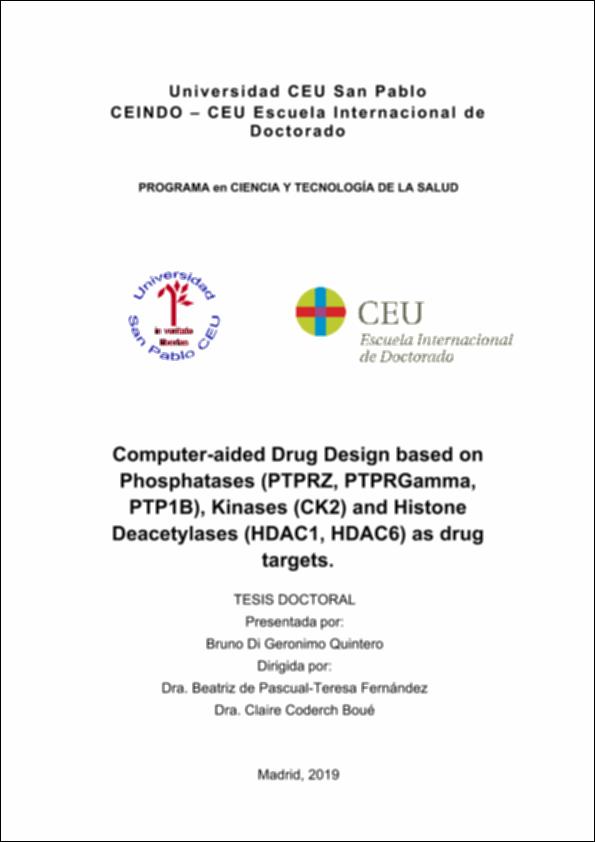Por favor, use este identificador para citar o enlazar este ítem:
http://hdl.handle.net/10637/13014Computer-aided Drug Design based on Phosphatases (PTPRZ, PTPRGamma, PTP1B), Kinases (CK2) and Histone Deacetylases (HDAC1, HDAC6) as drug targets.
| Título : | Computer-aided Drug Design based on Phosphatases (PTPRZ, PTPRGamma, PTP1B), Kinases (CK2) and Histone Deacetylases (HDAC1, HDAC6) as drug targets. |
| Autor : | Di Geronimo Quintero, Bruno |
| Materias: | Descubrimiento de fármacos, modelado molecular; Fosfatasasa y enfermedades neurodegenerativas; Drug discovery; Phosphatases and neurodegenerative diseases; Molecular modelling |
| Resumen : | Este trabajo está basado en el desarrollo de una nueva serie de pequeñas moléculas con capacidad de atravesar la barrera hematoencefálica, que presentan gran actividad y selectividad frente a PTPRZ1 para el tratamiento del uso abusivo del alcohol y sus efectos reforzadores. Para ello el uso de las herramientas computacionales ha sido fundamental. La actividad de estas moléculas se basa en la inhibición directa de la actividad catalítica de PTPRZ1, con el fin de mimetizar la actividad de la pleiotrofina (PTN), una hormona cerebral implicada en enfermedades neurodegenerativas que es el ligando natural de esta fosfatasa. Como resultado, dos pequeñas moléculas 10a y 12b han sido seleccionadas por su alta actividad inhibitoria frente a PTPRZ1, con valores por debajo de micromolar, y por su capacidad de atravesar la membrana hematoencefálica en ensayos in vitro e in vivo. Además, estas pequeñas moléculas han sido ensayadas en otras fosfatasas con el objetivo de evaluar su de selectividad. Los prometedores resultados de dichas moléculas han permitido el ensayo directo en ratones, que ha corroborado tanto la implicación de PTPRZ1 en el mecanismo de adicción a drogas, como su potencial como diana farmacológica para este tipo de enfermedades. This work is focused on the discovery of a new series of small molecules within the ability to cross the blood-brain barrier, which show great activity and selectivity against PTPRZ1 for the treatment of alcohol abuse and its reinforcing effects. For this, the use of computational tools has been fundamental. The activity of these molecules is based on the direct inhibition of the catalytic activity of PTPRZ1, in order to mimic the activity of pleiotrophin (PTN), a brain hormone involved in neurodegenerative diseases that is the natural ligand of this phosphatase. As a result, two small molecules 10a and 12b were selected for their high inhibitory activity against PTPRZ1, with values below micromolar, and for their ability to cross the blood-brain membrane in in vitro and in vivo assays. Furthermore, these small molecules have been tested for other phosphatases in order to evaluate their selectivity. The promising results of these molecules have allowed direct testing in mice, which has corroborated both the involvement of PTPRZ1 in the mechanism of drug addiction, as well as its potential as a pharmacological target for this type of diseases. |
| Descripción : | Tesis-CEINDO, Universidad San Pablo CEU, Programa en Ciencia y Tecnología de la Salud, leida el 11 de junio de 2020 |
| Director(es): | Pascual-Teresa Fernández, Beatriz de |
| URI : | http://hdl.handle.net/10637/13014 |
| Derechos: | http://creativecommons.org/licenses/by-nc-nd/4.0/deed.es |
| Fecha de publicación : | 21-sep-2021 |
| Centro : | Universidad San Pablo-CEU |
| Aparece en las colecciones: | Ciencia y Tecnología de la Salud |
Los ítems de DSpace están protegidos por copyright, con todos los derechos reservados, a menos que se indique lo contrario.


